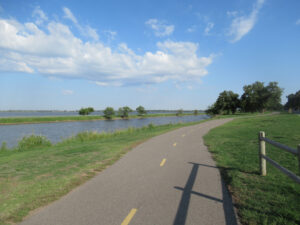 I hadn’t seen Lake Overholser in several months. It hasn’t changed, but I couldn’t resist this shot showing the flow channel (foreground) alongside the lake itself (background). The whole point is that water that the city draws from the lake has a long rest so the silt precipitates. Meanwhile, the channel can flow independently toward a separate gate on the dam. The channel is often a different color from the clearer lake water.
I hadn’t seen Lake Overholser in several months. It hasn’t changed, but I couldn’t resist this shot showing the flow channel (foreground) alongside the lake itself (background). The whole point is that water that the city draws from the lake has a long rest so the silt precipitates. Meanwhile, the channel can flow independently toward a separate gate on the dam. The channel is often a different color from the clearer lake water.
 This is a bikeway overpass under construction near Wilshire on the Northwest Expressway. For several months, the bridge itself was being assembled in the center median (just visible as a frame on the ground). At long last, when it was ready, crews began pouring concrete for the ramps on both sides. The bridge will be dropped into place after some of the matching fixtures have been added. The path originally ran through some parking lots and cyclists had to get into the traffic queue to cross at the light. The diversion to this new crossing has already been laid, but it will take close to, or into, the new calendar year before this thing is finished and ready to use.
This is a bikeway overpass under construction near Wilshire on the Northwest Expressway. For several months, the bridge itself was being assembled in the center median (just visible as a frame on the ground). At long last, when it was ready, crews began pouring concrete for the ramps on both sides. The bridge will be dropped into place after some of the matching fixtures have been added. The path originally ran through some parking lots and cyclists had to get into the traffic queue to cross at the light. The diversion to this new crossing has already been laid, but it will take close to, or into, the new calendar year before this thing is finished and ready to use.
 This is just a nicely kept pasture up on Westminster Road north of Britton Road. This is the same pasture that has the cedar limbs used to stabilize the fence cables. Everyone I see around the property is Hispanic, which may help to explain why the place looks so very different from all the other properties up in this part of the county. There are very few Latinos in these parts.
This is just a nicely kept pasture up on Westminster Road north of Britton Road. This is the same pasture that has the cedar limbs used to stabilize the fence cables. Everyone I see around the property is Hispanic, which may help to explain why the place looks so very different from all the other properties up in this part of the county. There are very few Latinos in these parts.
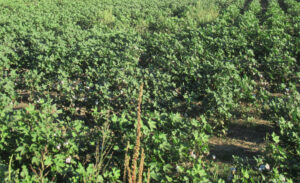 The primary crop in this picture is cotton. However, you can tell it’s some kind of “Round-up Ready” crop because of the Amaranth growing in it as weeds. Amaranth (AKA “pigweed”) is one of the first native plants to build a resistance to Round-Up, so they are the most visible “weed” in any crop. By the way, the entire Amaranth plant is edible, but you won’t see much of it in the grocery stores. That’s another story.
The primary crop in this picture is cotton. However, you can tell it’s some kind of “Round-up Ready” crop because of the Amaranth growing in it as weeds. Amaranth (AKA “pigweed”) is one of the first native plants to build a resistance to Round-Up, so they are the most visible “weed” in any crop. By the way, the entire Amaranth plant is edible, but you won’t see much of it in the grocery stores. That’s another story.
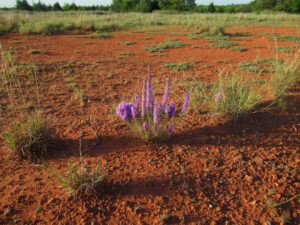 Up on a high ridge near Draper Lake I spotted this purple wild flower. This is by far the finest example of that particular plant. They grow all over the place, but nothing I’ve seen elsewhere was quite this full and tall. I came back a week later and it was nowhere to be seen. There was no evidence of disturbance, so I assume it burst into glory and then died on its own.
Up on a high ridge near Draper Lake I spotted this purple wild flower. This is by far the finest example of that particular plant. They grow all over the place, but nothing I’ve seen elsewhere was quite this full and tall. I came back a week later and it was nowhere to be seen. There was no evidence of disturbance, so I assume it burst into glory and then died on its own.
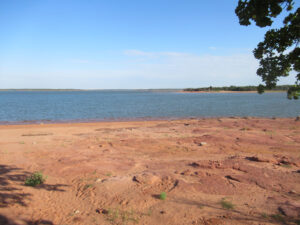 In all the years I’ve been visiting Draper Lake, I’ve never seen it this low. Normally the water would be at my feet and about knee deep. Here’s it several meters out from the shore. I don’t know if this drought has been so long and harsh, but Oklahoma City is sucking down the water more than I’ve ever seen. It’s been down low for so long that big stretches of exposed flat shore areas now have a fresh growth of pioneer plants covering them in places. This part remains clear largely because it’s mostly rock, but also because it’s in the lee of the prevailing winds, and there are trees growing on a low bluff shoreline. The wind-borne seeds pass over this area.
In all the years I’ve been visiting Draper Lake, I’ve never seen it this low. Normally the water would be at my feet and about knee deep. Here’s it several meters out from the shore. I don’t know if this drought has been so long and harsh, but Oklahoma City is sucking down the water more than I’ve ever seen. It’s been down low for so long that big stretches of exposed flat shore areas now have a fresh growth of pioneer plants covering them in places. This part remains clear largely because it’s mostly rock, but also because it’s in the lee of the prevailing winds, and there are trees growing on a low bluff shoreline. The wind-borne seeds pass over this area.
 The new bikeway under construction along NE 4th between the river and the Katy Trail has gotten this far. This honestly isn’t that much better than when the crews had simply chiseled down the old concrete barriers. Still, it’s nice that they have left it open so that cyclists can easily pass through. The crews on this contract aren’t that numerous, and so they are constantly shifting to other parts of the project and leaving this stretch for weeks at a time. Meanwhile, it remains blocked to all motor traffic.
The new bikeway under construction along NE 4th between the river and the Katy Trail has gotten this far. This honestly isn’t that much better than when the crews had simply chiseled down the old concrete barriers. Still, it’s nice that they have left it open so that cyclists can easily pass through. The crews on this contract aren’t that numerous, and so they are constantly shifting to other parts of the project and leaving this stretch for weeks at a time. Meanwhile, it remains blocked to all motor traffic.
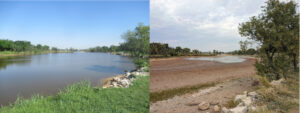 These paired photos show the same cove on Hefner Lake, another major water reservoir for Oklahoma City. Only Overholser has been spared this level of depletion. That’s because Overholser is right on the North Canadian River and wildlife depends on the water level. Overholser is actually a main feed for Hefner, as water runs through a canal between the two as needed. The dam that rings Hefner is massive, and the reservoir is very deep, but this cove is on the far shore opposite the dam.
These paired photos show the same cove on Hefner Lake, another major water reservoir for Oklahoma City. Only Overholser has been spared this level of depletion. That’s because Overholser is right on the North Canadian River and wildlife depends on the water level. Overholser is actually a main feed for Hefner, as water runs through a canal between the two as needed. The dam that rings Hefner is massive, and the reservoir is very deep, but this cove is on the far shore opposite the dam.

